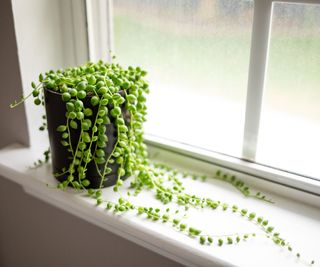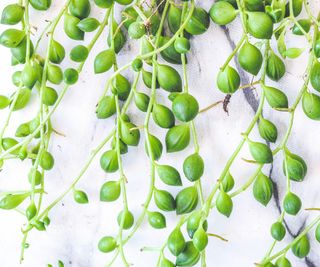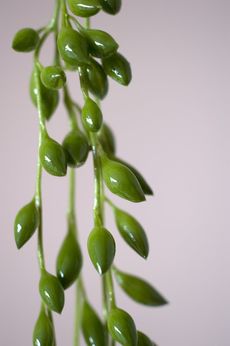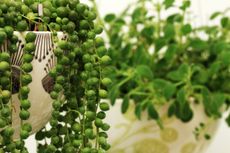String Of Pearls Plant: Everything You Need To Know For Happy Plants
Also known as string of beads, the string of pearls plant is an easygoing succulent that quickly adds vertical interest to any room. Here’s how to make the most of yours


The world of succulents is diverse and varied, a great example being the string of pearls plant (Curio rowleyanus). Also known as string of beads, the plant’s appearance echoes that of its names. Cascading stems are adorned with distinctive pea-like leaf structures that call to mind an elegant string of pearls.
Sprawling over the edges of containers or hanging baskets, this creeping succulent is a novel addition to a home or indoor garden. Caring for a string of pearls plant is as straightforward as most succulents. All you need is the right light, water levels and soil to care for this houseplant and give it a happy environment in which to flourish.
Quick String of Pearl Facts:
- Botanical name: Curio rowleyanus
- Height: 2ft (60cm)
- Spread: 1ft (30cm)
- Soil requirements: Well draining
- Hardiness zones: USDA 9-11

String of Pearls Care
Succulents are known for their easy maintenance and stoic nature. The string of pearls succulent is no exception. It is primarily grown as a houseplant due to its intolerance of cold, and is often grown in a hanging basket to accommodate the drooping, slender stems.
In its native range, South Africa, the plant will drape itself over rocks and other items, spreading into a mat. The stems will root where they touch the soil, making this an easy plant to propagate. However, these tips will help you better care for string of pearls:
- Light: Found growing wild in the eastern Cape of South Africa, string of beads is in the aster family. Its native range sees the plant growing in bright sunny areas. As a houseplant, situate the plant’s container slightly away from a western window. String of pearls succulent plants can be moved outdoors during the warm months, but should be placed in an area with shelter from noonday rays to avoid sunburning the leaves. In warm regions, the plant may be grown in-ground, but should be sited where there is a bit of cover from the harshest rays of the sun.
- Water: Curio rowleyanus grows naturally in almost desert scapes. It is very tolerant of drought, but the best growth comes from regular watering, which is done properly. Watering once a week works well. Water the plant deeply, but allow the soil to dry out half an inch (1cm) before giving it more water. Watering too often can increase the chances of root rot. During the winter months, when the plant is dormant and not actively growing, cut watering back to around once monthly. Resume normal watering in spring. Succulents can be sensitive to some municipal tap water. Allow the water to offgas overnight before using it on the plant.
- Temperature & Humidity: The ideal temperatures for best growth are 70-80 degrees Fahrenheit (21-27°C). This plant is hardy in United States Department of Agriculture hardiness zones 9-11 and has no freeze tolerance. During dormancy in winter, the plant will withstand temperatures down to 50°F (10°C).
- Soil & Compost: A string of pearls plant requires very well-draining soil. As a houseplant, use a sandy cactus potting soil or succulent mix. To make your own soil, mix a 3:1 mixture of potting soil and gritty sand. Perlite and pumice are acceptable substitutes for sand. Pot your plant in a hanging basket so its trailing foliage can hang down. In-ground plants need loam amended with the addition of sand or gravel.
- Fertilizer: Like most succulents, a string of beads doesn't need extra fertilizer to grow. Add some time-release granules to the soil at planting to encourage rooting and leaf formation. Mature plants will respond well to bi-weekly feeding with a balanced fertilizer, diluted by half during the growing season. Suspend feeding in the fall and resume in early spring.
- Pruning: Occasionally, you may find that pruning plants becomes necessary as part of your string of pearls care in order to maintain its size or appearance. This is simple to do. Trim off any dead stems and pearls, as well as any stems that have lost a lot of their beads. Pruning back will help promote fuller, more compact plants.

How to Make String of Pearls Flower
As well as knowing how to care for string of pearls as a delicate and quirky plant in its own right, you may also wish to cultivate its flowers. The blooms of this succulent are said to be tiny and insignificant but they smell delicious, similar to cinnamon.
Cultivate cool, dry conditions in the winter months to spur flower formation. A temperature of 60°F (16°C) and limited watering in the cold season will signal to the plant that it is time to form buds. The plant will bloom in spring and fill the house with scent.
String of Pearls Propagation
After a few years, the string of pearls succulent will begin to die back. This is normal, and you can use propagation to establish a new plant. It is possible to grow plants by placing a round leaf on a soilless medium, but a quicker method is by cutting. You can coincide this with pruning if it helps. Remove a stem of 3in (8cm) in length. Insert the cutting into pre-moistened media, and it will shortly root.
Gardening tips, videos, info and more delivered right to your inbox!
Sign up for the Gardening Know How newsletter today and receive a free download of our most popular eBook "How to Grow Delicious Tomatoes."

Repotting String of Pearls
You can plant string of pearls in containers and leave the plant for quite a while, and they actually like a crowded pot. However, a recharge of new planting media will encourage growth and maintain the health of the plant. The best time for repotting is late winter to early spring, while the plant is dormant. To ensure that excess moisture is dispersed, select a container with several drainage holes, and consider using an unglazed pot that will evaporate moisture.
Common Problems with String of Pearls Plants
Often, string of beads will lose the round leaves and stems will be bereft of foliage. Simply cut these off as they occur. Plants brought outdoors may experience pest issues like aphids, mealybugs and scale.
Overwatering can cause the plant to rot, while underwatering will see the pea-like leaves pucker and shrivel. Maintaining a healthy, well-timed watering routine with the correct compost or soil should help to alleviate and prevent some of these issues.

Bonnie Grant is a professional landscaper with a Certification in Urban Gardening. She has been gardening and writing for 15 years. A former professional chef, she has a passion for edible landscaping.
- Nikki TilleySenior Editor
-
 How To Grow Garden To Table: A Guide For Home Cooks
How To Grow Garden To Table: A Guide For Home CooksWhat could be better than a meal that comes directly from garden to table? Show off your gardening and culinary skills with the very freshest food.
By Bonnie L. Grant
-
 Want a Backyard Mini Orchard? Create Your Own Container Orchard
Want a Backyard Mini Orchard? Create Your Own Container OrchardEasier to care for in small spaces, a backyard mini-orchard makes sense for busy gardeners and juicy fruit is the reward.
By Teo Spengler
-
 String Of Bananas Info: Caring For String Of Bananas Plant Indoors
String Of Bananas Info: Caring For String Of Bananas Plant IndoorsString of bananas displays cascading vines of succulent, banana-shaped leaves year round and tiny lavender, yellow or white blooms during fall and winter. Want to learn how to grow this plant? Click here and we'll provide helpful string of bananas information to get your started.
By Mary H. Dyer
-
 String Of Pearls Propagation : Tips For Rooting String Of Pearls Cuttings
String Of Pearls Propagation : Tips For Rooting String Of Pearls CuttingsString of pearls plant cuttings root readily provided they have a bit of preparation and the correct medium. The trick is in knowing how to propagate a string of pearls plant, including when to take the cutting. This article will help with that.
By Bonnie L. Grant